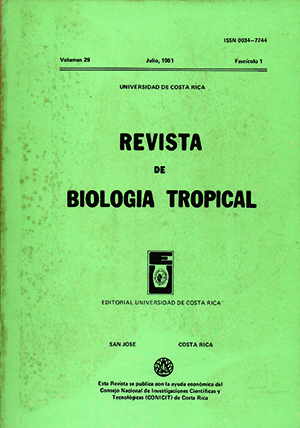Abstract
Red tides in the Golfo de Nicoya, Costa Rica, are caused by Cochlotinium catenatum Okamura. The maximum concentration of cells was 80x106 /L. Four-celled colonies dominate in natural samples, while in culture, unicells and pairs are more common. Measurements of primary productivity were impractical because of cell autolysis. Environmental conditions controlling initiation and termination of blooms are unknown. The red tide is apparently non-toxic.References
Boleyn, B. J. 1967. A simple pipette control for isolating planktonic algae. Can. J. Microbiol., 13: 1129-1130.
Fenaz-Reyes, E., G. Reyes-Vásquez, & I. B. Bruzual. 1979. Dinoflagellate blooms in the Gulf of Cariaco, Venezuela, p. 191-194. In D. L. Taylor & H. H. Seliger (eds.), Toxic Dinoflagellate Blooms. Elsevier-North Holland, Inc., New York.
Guillard, R.R.L., & J. H. Ryther. 1962. Studies of marine planktonic diatoms. I. Cyclotella ruma Hustedt and Detonula confervacea (Cleve) Gran Can. J. Microbiol., 8: 229-239.
Hayes, H. L. & T. S. Austin. 1951. The distribution of discolored seawater. Texas J. Sci., 3: 530-541.
Kofoid, C. A., & O. Swezy. 1921. The free-living unarmored Dinoflagellata. Mem. Univ. Calif. (Berkeley), 5: 1-562.
Margalef, R. 1961. Hidrografía y fitoplancton de un área marina de la costa meridional de Puerto Rico. Invest. Pesq., 18: 33-96.
Peterson, C. L. 1960. The physical oceanography of the Gulf of Nicoya, Costa Rica, a tropical estuary. Bull. Inter-Amer. Trop. Tuna Comm., 4: 138-190.
Reyes-Vásquez, G., E. Ferraz-Reyes, & E. Vásquez. 1979. Toxic dinoflagellate blooms in northeastern Venezuela during 1977. In Toxic Dinoflagellate Blooms. Elsevier-North Holland, Inc.
Silva, E. S. 1967. Cochlodinium heterolobatum n. sp.: structure and some cytophysiological aspects. J. Protozool., 14: 745-754.
##plugins.facebook.comentarios##

This work is licensed under a Creative Commons Attribution 4.0 International License.
Copyright (c) 1981 Revista de Biología Tropical


